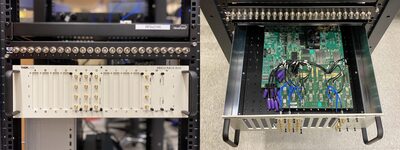Cost-efficient control electronics for quantum computers

When designing a next-generation quantum computer, a surprisingly large problem is bridging the communication gap between the classical and quantum worlds. A new system of control and readout electronics, developed by engineers at the US Department of Energy’s Fermi National Accelerator Laboratory, has now proved to improve quantum computer performance while cutting the cost of control equipment.
The fast and cost-efficient controls were developed by Fermilab engineers led by senior principal engineer Gustavo Cancelo, whose goal was to create and test an FPGA-based controller for quantum computing experiments. David Schuster, a physicist at The University of Chicago, led the university lab that helped with the specifications and verification on real hardware. The new system, known as the Quantum Instrumentation Control Kit (QICK), has been described in the journal Review of Scientific Instruments.
Quantum computers are based on the counterintuitive, probabilistic rules of quantum mechanics that govern the microscopic world, which enables them to perform calculations that ordinary computers cannot. Because people live in the macroscopic visible world where classical physics reigns, control and readout electronics act as the interpreter connecting these two worlds. Control electronics use signals from the classical world as instructions for the computer’s quantum bits, or qubits, while readout electronics measure the states of the qubits and convey that information back to the classical world.
Currently, most control and readout systems for superconducting quantum computers use off-the-shelf commercial equipment not specialised to the task. As a result, researchers often must string together a dozen or more expensive components. The cost can quickly add up to tens of thousands of dollars per qubit, and the large size of these systems creates more problems. Furthermore, despite recent technological advances, qubits still have a relatively short lifetime — generally a fraction of a millisecond — after which they generate errors.
“When you work with qubits, time is critical,” Cancelo said. “Classical electronics take time to respond to the qubits, limiting the performance of the computer.”

Just as the effectiveness of an interpreter depends on rapid communication, the effectiveness of a control and readout system depends on its turnaround time — and a large system made of many modules means long turnaround times. To address this issue, Cancelo and his team designed a compact control and readout system, incorporating the capabilities of an entire rack of equipment in a single electronics board slightly larger than a laptop. The new system is specialised, yet it is versatile enough to be compatible with many designs of superconducting qubits.
“We are designing a general instrument for a large variety of qubits, hoping to cover those that will be designed six months or a year from now,” Cancelo said. “With our control and readout electronics, you can achieve functionality and performance that is hard or impossible to do with commercial equipment.”
The control and readout of qubits depend on microwave pulses — radio waves at frequencies similar to the signals that carry mobile phone calls and heat up microwave dinners. The Fermilab team’s radio frequency (RF) board contains more than 200 elements: mixers to tweak the frequencies, filters to remove undesired frequencies, amplifiers and attenuators to adjust the amplitude of the signals and switches to turn signals on and off. The board also contains a low-frequency control to tune certain qubit parameters.

Together with a commercial FPGA board, which serves as the ‘brains’ of the computer, the RF board provides everything scientists need to communicate successfully with the quantum world. The two compact boards cost about 10 times less to produce than conventional systems, and in their simplest configuration they can control eight qubits. Integrating all the RF components into one board allows for faster, more precise operation as well as real-time feedback and error correction.
“You need to inject signals that are very, very fast and very, very short,” said Fermilab team member Leandro Stefanazzi. “If you don’t control both the frequency and duration of these signals very precisely, then your qubit won’t behave the way you want.”
Designing the RF board and layout took about six months and presented substantial challenges: adjacent circuit elements had to match precisely so that signals would travel smoothly without bouncing and interfering with each other. Plus, the engineers had to carefully avoid layouts that would pick up stray radio waves from sources like mobile phones and Wi-Fi. The design is now ready for fabrication and assembly, with the goal of having working RF boards by mid-year.
The Fermilab engineering team has also taken advantage of a new commercial FPGA chip, the first to integrate digital-to-analog and analog-to-digital converters directly into the board. It substantially speeds up the process of creating the interface between the FPGA and RF boards, which would have taken months without it. To improve future versions of its control and readout system, the team has started designing its own FPGA hardware.
Finally, the new system is easily scalable. Frequency multiplexing qubit controls, analogous to sending multiple phone conversations over the same cable, would allow a single RF board to control up to 80 qubits. Furthermore, thanks to their small size, several dozen boards could be linked together and synchronised to the same clock as part of larger quantum computers.
A low-cost version of the hardware is now available for universities for educational purposes, allowing smaller institutions to have powerful quantum control without spending hundreds of thousands of dollars.
Please follow us and share on Twitter and Facebook. You can also subscribe for FREE to our weekly newsletter and bimonthly magazine.
Light reshapes semiconductors for advanced optical devices
Researchers have shown how light reshapes Janus semiconductors at the atomic scale, enabling...
Novel method to grow ultrathin semiconductors on electronics
Researchers have developed a technique that could speed up the development of next-generation...
Blue LEDs developed to enhance display performance
Researchers have developed a new method for manufacturing light-emitting diodes (LEDs) that emit...




